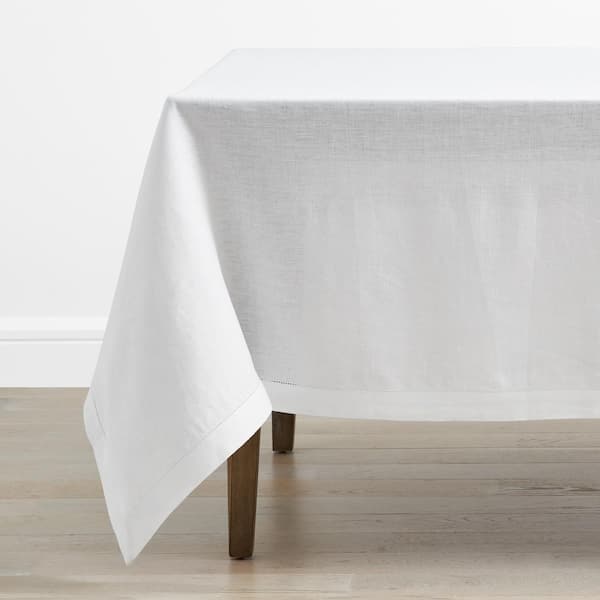Elegant Table Cloths: Perfect Choices for Every Occasion
Wiki Article
Linen Textile Advancements: Exploring Modern Trends and Creative Applications in Design and Textile Market
From sustainable manufacturing approaches to cutting-edge weaving innovations, the advancement of bed linen is improving the landscape of the fabric sector. As we dive right into the realms of creative layout applications and the appearance of linen blends and hybrid fabrics, a new phase unfolds in which linen's function in future fabric advancements takes facility phase.Lasting Practices in Linen Manufacturing
Lasting methods in linen manufacturing have come to be significantly vital in the fabric industry's initiatives to lessen ecological impact and advertise honest sourcing approaches. Linen, a natural fiber stemmed from the flax plant, provides a series of benefits such as biodegradability, breathability, and sturdiness. Nonetheless, traditional approaches of linen manufacturing can involve substantial water consumption, chemical usage, and energy-intensive processes.To resolve these challenges, lots of textile suppliers are embracing lasting practices throughout the linen manufacturing procedure. This includes sourcing flax from organic ranches that prevent unsafe pesticides and chemicals, applying water-efficient retting techniques to essence fibers from the flax stalks, and making use of environment-friendly dyes and coatings. Additionally, some business are buying renewable resource resources to power their manufacturing facilities and decreasing waste with recycling and upcycling campaigns.
Technological Innovations in Linen Weaving
With the growing emphasis on lasting techniques in bed linen production, the textile market is now seeing a rise in technological improvements especially focused on changing the art of bed linen weaving. These technologies are improving the means linen materials are produced, providing raised efficiency, top quality, and creativity in weaving strategies.Among the vital technical advancements in bed linen weaving is the assimilation of computerized looms. These innovative looms are equipped with software program that allows for complex and complicated layouts to be woven with precision. By digitizing the weaving procedure, suppliers can achieve higher uniformity and precision in their bed linen textiles.
Moreover, developments in yarn spinning innovation have allowed the production of finer and even more sturdy linen yarns - table cloths. This leads to softer and smoother bed linen materials that maintain their high quality even after numerous uses and cleans
In addition, the growth of environmentally friendly dyeing processes and coatings for bed linen textiles is gaining grip. These sustainable methods not only decrease the environmental influence but additionally deal with the boosting consumer need for ethically created textiles.
Creative Design Applications for Linen
Cutting-edge imaginative strategies are significantly shaping the imaginative layout applications for bed linen in the fabric market. Linen's natural aesthetic allure and capability to blend with various other textiles make it a favorite choice for producing distinct garments and devices that cater to the ecologically mindful customer.Moreover, developers are trying out bed linen in home decor, utilizing its breathable and resilient nature to craft stylish furnishings such as curtains, bed linen, and upholstery. The structure and drape of linen bring a feeling of elegance and convenience to indoor rooms, including a touch of sophistication to modern-day homes.

Linen Blends and Hybrid Fabrics

Crossbreed materials, on the other hand, take the idea of blending a step additionally by integrating additional components such as metallic threads, recycled materials, or conductive fibers. These innovative fabrics not just broaden the layout opportunities but likewise present functional aspects like conductivity, antimicrobial homes, or enhanced longevity. Crossbreed fabrics are significantly being utilized in numerous industries, consisting of fashion, interior decoration, and technological fabrics, where the demand for multifunctional products is on the increase.
Bed linen's Function in Future Fabric Innovations

In the world of future fabric innovations, linen is expected to be a principal in the development of sophisticated practical textiles. Scientists and developers are exploring methods to improve bed linen's integral qualities through technological developments, such as integrating wise fabrics, nanotechnology, and efficiency coatings. These technologies aim to elevate linen's performance characteristics, making it appropriate for a wider variety of applications, from activewear to protective garments.
Additionally, the mix of bed linen with various other all-natural or synthetic fibers opens up unlimited possibilities for producing unique fabrics with unique residential properties and functionalities. By leveraging linen's qualities and checking out ingenious blends, the fabric sector is poised to introduce exciting advancements that accommodate advancing consumer requirements and sustainability demands.
Verdict
To conclude, the expedition of sustainable techniques, technological developments, official website innovative layout applications, bed linen blends, and its function in future textile advancements highlight the continual development of bed linen textile in the modern style and textile market. With a concentrate on technology and creativity, the flexibility and green nature of bed linen make it a valuable product for producers and designers alike, leading the way for more growths and innovations in the field of fabrics.As we dig into the realms of creative layout applications and the appearance of bed linen blends and crossbreed materials, a new chapter table runner unfolds in which bed linen's duty in future textile innovations takes facility stage.
Checking out the combination of linen with various other fabrics has actually led to the emergence of ingenious blends and hybrid fabrics in the modern textile market. Linen blends provide a distinct combination of the characteristics of linen with those of various other fibers, resulting in materials that possess improved properties such as increased durability, boosted draping, and minimized wrinkling.The development of bed linen blends and hybrid textiles has established the phase for Linen to play a pivotal function in driving future fabric advancements.In the world of future textile advancements, linen is anticipated to be a key gamer in the development of sophisticated functional materials.
Report this wiki page